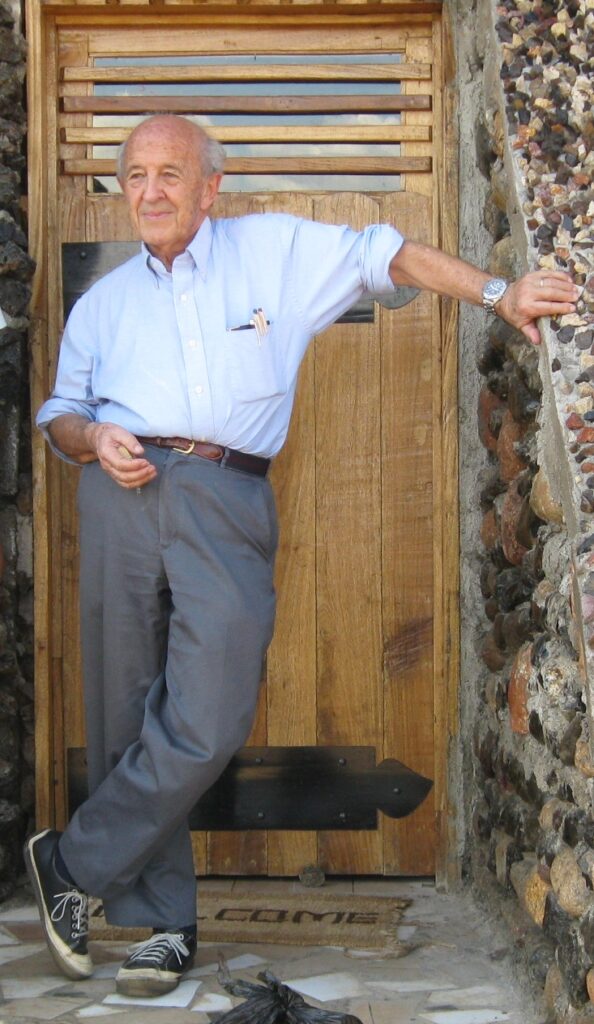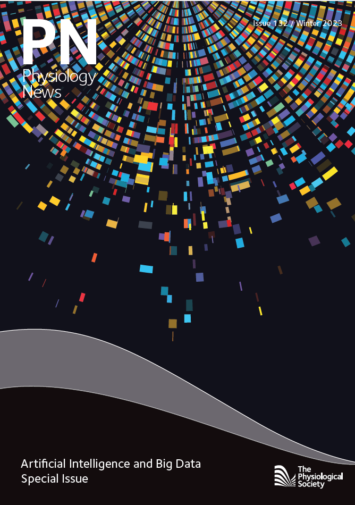
Physiology News Magazine
Obituary: John Nicholls (1929-2023)
Membership
Obituary: John Nicholls (1929-2023)
Membership
https://doi.org/10.36866/pn.132.46
Jonathan Ashmore and Alasdair Gibb,
University College London, UK
John Graham Nicholls cast a spell over us all. Whether for the hilarious tales of his life, recounted in Pioneers of Neurobiology: my brilliant eccentric heroes (Nicholls, 2015), or for his many formative research contributions to neurobiology, or for the influence of his lectures, or – and this may be the most familiar to readers of Physiology News – by writing the first modern neuroscience text book with Stephen Kuffler, From Neuron to Brain.

John Nicholls was born in London to parents who had left Germany in the 1920s. It was a cultured background. He went to school first at The King Alfred School in Hampstead, a progressive school, which must have encouraged his mischievous and very obvious sense of humour. It was a school that one of us also attended who, when asked whether we wanted to learn woodwork or reading, the choice was so clear that it made a laboratory career inevitable. After attending Berkhamsted, which he hated, for the scholarly training that King Alfred had trouble providing, John studied a BSc in Physiology from King’s College London before graduating MBBS from Charing Cross Medical School. He joined the Biophysics Department at University College London (UCL) in 1951. There he was supervised by Bernard Katz for whom he retained a profound admiration. This was the formative influence both in terms of his interest in cellular physiology and for the great spread of contacts he developed through that department.
After completing both his PhD and his medical training, John became a research fellow at UCL and at the University of Oxford. He then gained positions in neuropharmacology at Harvard University and in physiology at Yale University before returning to Harvard to join Kuffler’s new neurobiology department. Started in 1966, this was the very first neurobiology department and set the style for all that subsequently became neuroscience. John’s early work with Kuffler laid the foundations for understanding ion movements around glia (Nicholls and Kuffler, 1964). This was followed by a period at Yale, where John lectured to standing-room only halls of medical students, and resulted in a collaboration with his life-long friend Denis Baylor that opened up the study of neurobiology in the leech (Baylor and Nicholls, 1969).
While at Yale a perfect example of John’s humour appeared in a letter to Science (Nicholls et al., 1967). At the time, reports had been published about worms, claiming that if worms that were trained to crawl in a maze for food were then ground up and fed to other worms, those worms seemed to perform better in the maze than controls! Inspired by this, John’s Science letter described an experiment to test whether a Tektronix 502 oscilloscope, unable to store images, could be converted to “indefinite persistence” by pounding up and grinding to dust the components of a “donor” Tektronix RM564 Storage Oscilloscope. After the dust was carefully washed and dried, it was then sprinkled over a “recipient” oscilloscope. John reported that in 18 out of 33 experiments an increase in image persistence was observed in the recipient oscilloscope!
In 1968 he became a professor in David Hubel’s Physiology Department at Harvard but only for a brief period. In 1973, he moved to Stanford University as a full professor to help found a neurobiology department there, Stanford may have felt it was missing out in this exciting new field. The main research focus of John’s laboratory at Stanford remained the leech. It was during his time at Stanford and three summers at the Salk Institute that he and Kuffler wrote the first edition of From Neuron to Brain (from Chile to China now known simply as “FN2B”). Four editions followed, all with John as coauthor. The book has been translated into many languages and it is now in its sixth edition.
Stanford was also where his collaborations with neuroscientists around the world subsequently led to the start of the International Brain Research Organization (IBRO)-funded Visiting Lecturer Team Programme (VLTP) bringing contemporary neuroscience ideas to students in developing countries. John thought that the most critical aspect of this programme was to give students the confidence to be able to give well-structured and concise scientific talks so that they could participate in scientific exchange anywhere. A considerable effort during these visits was devoted to students practising presentations about their own project work. The model was of course the original communication style for The Physiological Society. The IBRO VLTP, subsequently organised together with his Stanford colleague Jack McMahan, visited over 40 countries over three decades, sometimes working in primitive conditions, but each time John and his co-opted lecturers found themselves talking to packed eager groups of students and faculty. A number of internationally distinguished neuroscientists owe their career beginnings to this programme.
John’s subsequent moves to the Biozentrum in Basel, Switzerland in 1983 as Professor of Pharmacology and finally as an emeritus professor to The International School for Advanced Studies (SISSA) in Trieste, Italy in 1998, are each characterised by a restless and inquisitive advance into a new area. His group in Basel worked on the developing spinal cord and the brainstem breathing rhythm using the short-tailed opossum, Monodelphis domestica, to find how the development of the cord takes place after birth.
John engaged all who met him. He remained an indefatigable traveller until his very last few years and hundreds of neuroscientists all over the world will have their own Nicholls stories. He believed a passion for science, music and cooking was an essential bond, while his lectures and teaching were masterclasses of presentation that captivated students everywhere. But maybe it is his powder blue jumper, so characteristically rolled up at the sleeves, the same colour as the FN2B cover, by which we shall also remember him.
References
Baylor DA, Nicholls JG (1969). Chemical and electrical synaptic connexions between cutaneous mechanoreceptor neurones in the central nervous system of the leech. Journal of Physiology 203, 591–609.
Nicholls JG (2015). PIoneers of Neurobiology: My Brilliant Eccentric Heroes. Sinauer Associates Inc, Sunderland, MA, USA.
Nicholls JG et al. (1967). Persistence Transfer. Science 158, 1524–1525.
Nicholls JG, Kuffler SW (1964). Extracellular space as a pathway for exchange between blood and neurons in the central nervous system of the leech: ionic composition of glial cells and neurons. Journal of Neurophysiology 27, 645–671.
